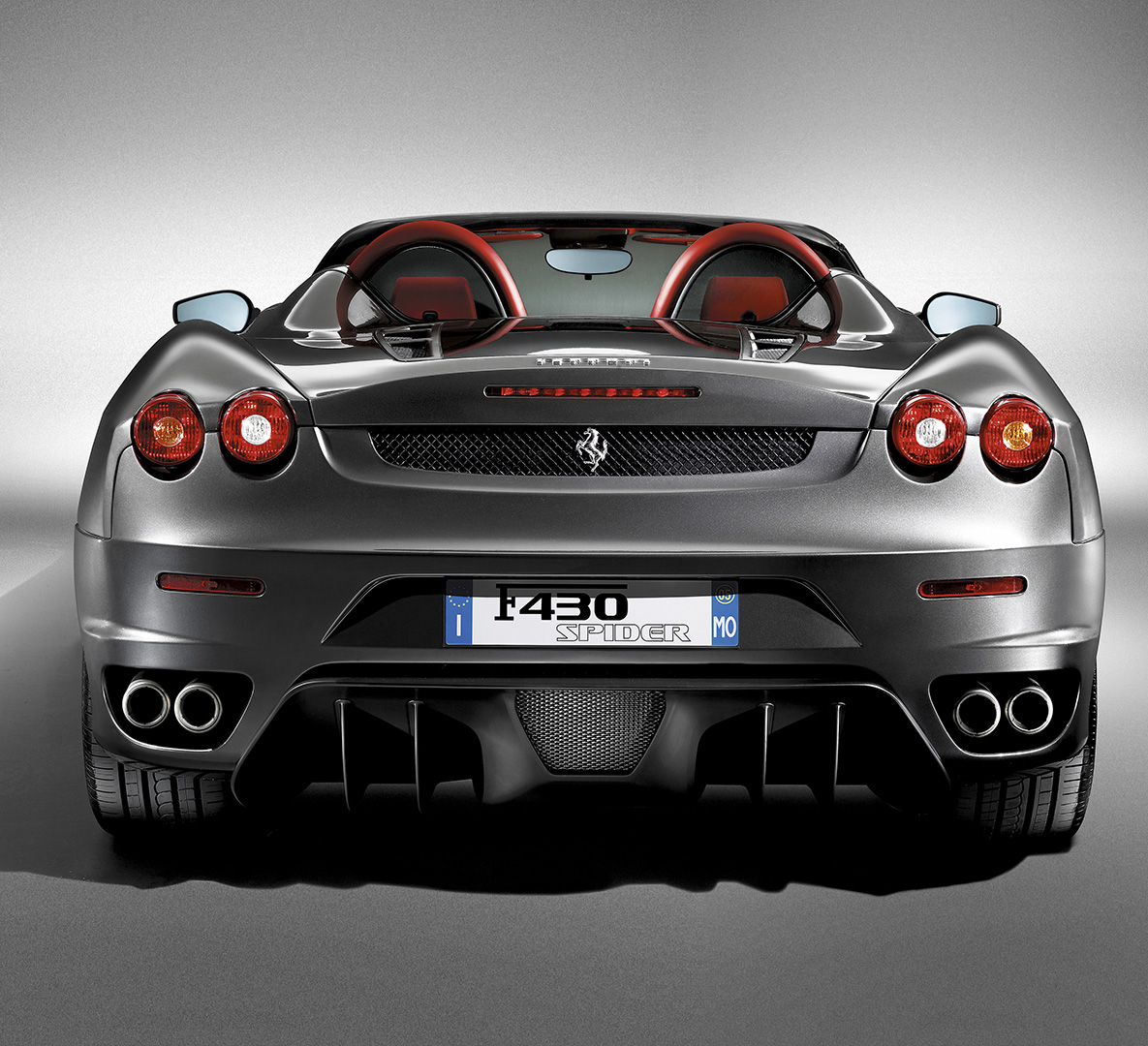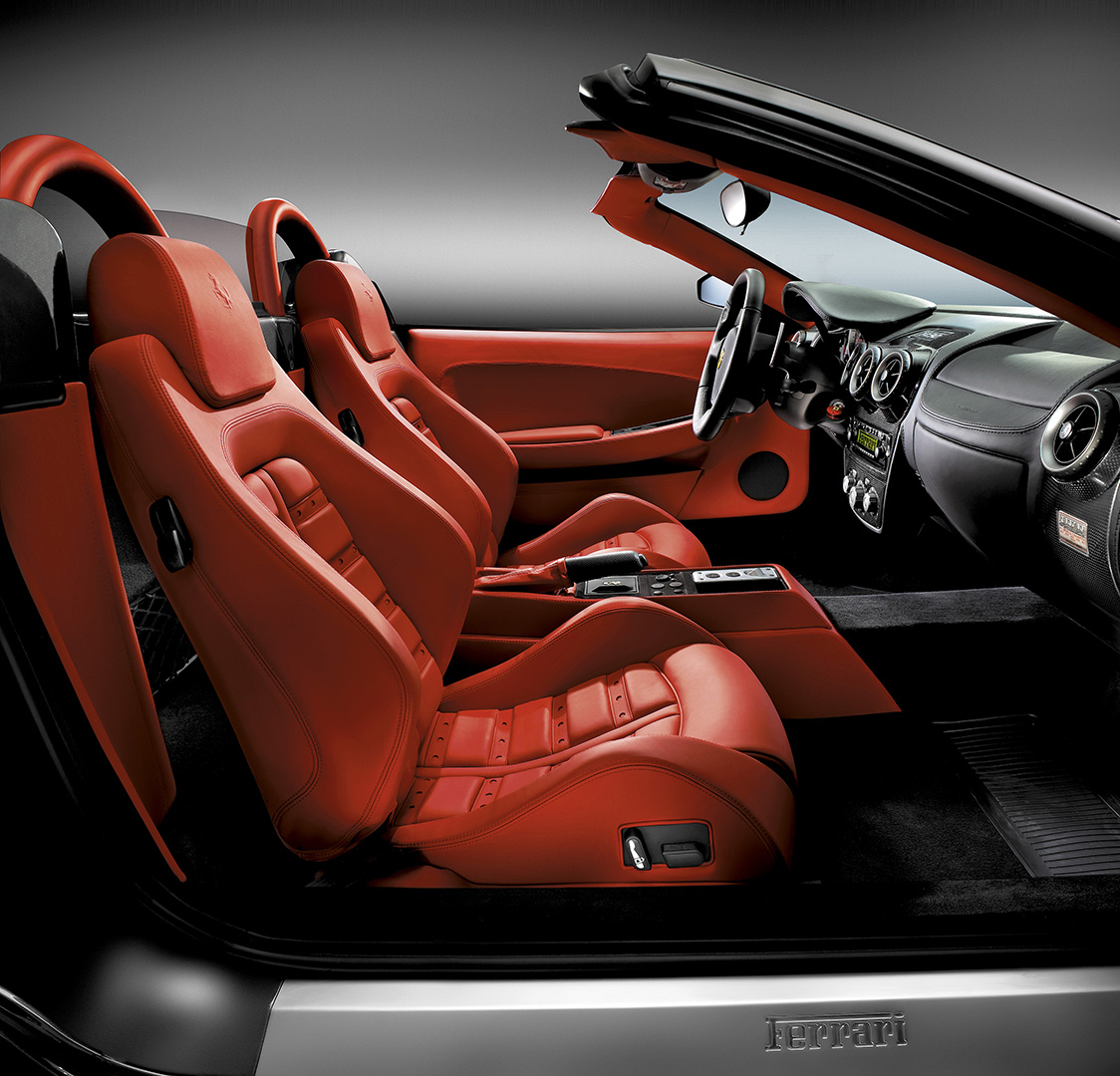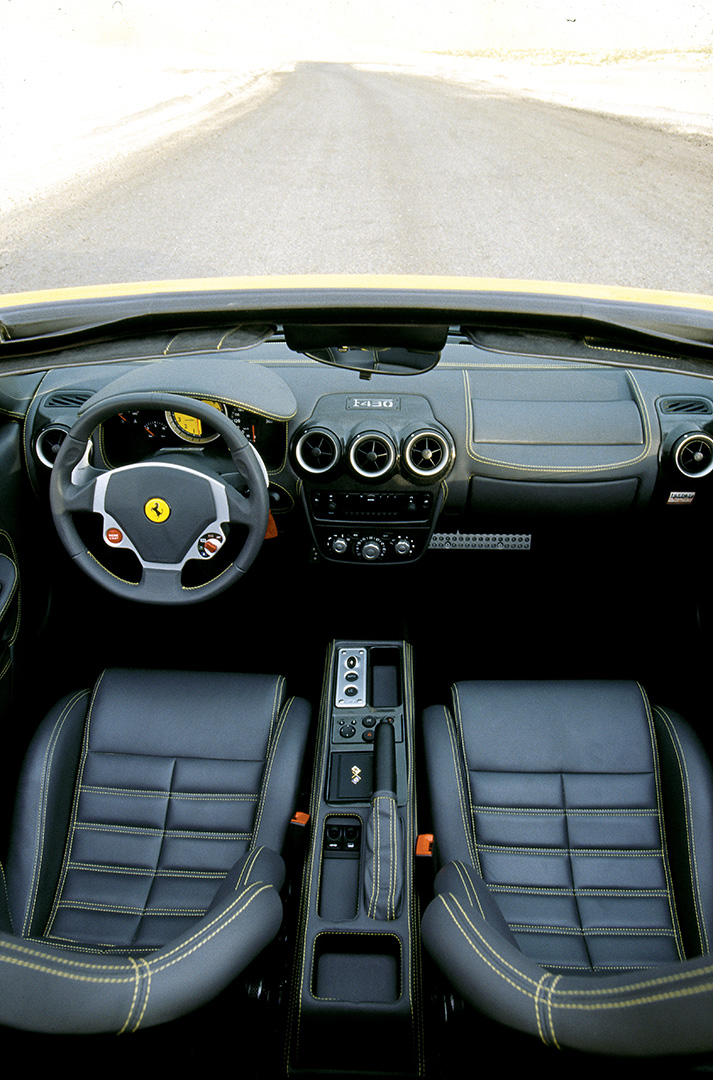?width=1920&height=1600)
FERRARI F430 SPIDER
Created by Pininfarina, the F430 Spider is inspired by the car’s exceptional engineering and Formula 1.

Inspired by Formula 1
The lines of the F430 Spider (created by Pininfarina in collaboration with Ferrari’s Head of Design), were inspired by the car’s exceptional engineering. As with every Ferrari,Pininfarina quite rightly took inspiration from the cars’exceptional engineering and performance. Long hours spent in the wind tunnel working with Ferrari’s aerodynamics specialists greatly influenced the muscular lines of both the coupé and spider versions. For instance, two distinctive elliptical air intakes channel air into the generously dimensioned radiators that cool the powerful engine.

The nose, which is characterised by two distinctive air intakes, draws inspiration from the Ferrari 156 F1 that Phil Hill drove to his F1 World Championship title in 1961. The Enzo Ferrari was the inspiration for much of the rear styling of the new F430 Spider, and the Ferrari meticulous aerodynamic detailing is reflected in the design of the nolder incorporated into the engine cover and the new rear diffuser integrated into the bumper, which boasts race-derived dimensions.

The meticulous work that has gone into optimising airflow through the car has given rise to a number of carefully contoured scoops and vents along the cars’ sides and rear. In fact, even the wing mirrors now have specially profiled twin mounting arms that channel the airflow smoothly towards the engine intakes. The cars’muscular stance has been further enhanced by stylistic and functional elements including the Enzo-inspired tail-lights which protrude from the bodywork, and the generous nolder incorporated into the engine cover.

The interior of the F430 Spider has been redesigned for improved driver ergonomics. The interior is exceptionally innovative as well as sporty. The instruments are housed in a new binnacle, and this design – together with the layout of the dashboard – underlines the care that has gone into grouping all the major controls within easy reach of the driver. In the driver’s direct line of sight are the rev counter, which features new graphics with a choice of either a red or yellow background and a new metal surround, the digital readout of the gear ratio selected (F1 version) and a multi-function display. The same uncompromising approach to driver control was the inspiration behind mounting the starter button and manettino on the steering wheel.

The cockpit is noticeably bigger and the already excellent passenger comfort is improved still further by a slimmer central tunnel which houses the gear lever turret on the manual version or the F1 console on the paddle-shift version. The seats have been redesigned for greater lateral containment too. Electric seats are available on request as is a racing version featuring a four-point safety harness (depending on market).
Each Ferrari to emerge from the factory at Maranello is absolutely unique, not just because it is hand-built, but also because a virtually endless combination of personalisation options is offered to each new owner.


Engine visible at all times
The only uncompromising, mid-engined drop-top to boast a compact, fully automatic electric hood that keeps the engine visible at all times. The F430 Spider has been developed using exactly the same engineering approach to computer development models and Wind Tunnel testing as used by the F1 team. Ferrari engineers have been able to modulate the air flow both around the car, as well as under it, and the result is a highly efficient configuration that channels air flow for maximum down-force and grip. Similarly, air is channelled to the engine to both increase power as well as optimise cooling of transmission and brakes, even under heaviest use. Perfecting the F430 Spider’s aerodynamics has brought about a 50% increase in down-force compared to the 360 Modena, thus increasing high-speed stability and the car’s active safety.
At 200 km/h, that figure equates to 45 kg more down-force than the 360 Modena; this becomes 85 kg at 300 km/h, amounting to a total of 280 kg. The significant progress made in the car’s aerodynamics is also reflected in the improvement of the ratio between the coefficient of down-force (Cl) and the drag coefficient (Cd), with a 40% improvement over the 360 Modena. This result was in part achieved by including a new spoiler at the bottom of the front bumper where it cleaves ‘clean’ air, i.e. air that’s undisturbed by the turbulence generated around the body of the vehicle.

Lengthy development of the shape and the angle of attack of the spoiler resulted in an increase in down-force over the front axle – up to 130 kg – which contributes to longitudinal vehicle stability and steering precision.The nolder on the trailing edge of the engine cover works in conjunction with the new diffuser between the rear wheels. The latter features similar fences (deflectors) to those used on Ferrari’s single-seaters, and increases the speed of air flow under the tail of the car creating an area of depression and ground effect that pulls the car down. In this conformation, the underbody actively helps increase down-force to a maximum of 150 kg over the rear axle. Aerodynamic development also played a part in extracting the maximum performance from the new 4.3-litre V8. The two intakes for the engine are positioned over the wheels in an area of high flow pressure, thus guaranteeing a greater volume of air to the intake manifold.
At high speeds, in fact, ram-effect induction accounts for 1% of the engine’s maximum power (490 hp). There is a new specific cooling system that makes the most of the new air intakes at the front, and the flow over the radiators positioned ahead of the wheels. Hot air from the radiators escapes through vents on the sides of the front bumpers in an area of vacuum that maximises the extraction effect. The engine compartment is cooled by air from two intakes set into the front of the rear wheel arches. The air is channelled and distributed to critical areas with a high thermal load to provide optimum cooling even under hard use. The brakes benefit from a greater air flow thanks to larger intakes and bigger diameter ducting. The new wheel design also helps maximise the expulsion of hot air from the brake discs to match their increased performance.


SHAPED INTO FERRARI WIND TUNNEL
The wind tunnel testing carried out to hone the F430 and F430 Spider’s aerodynamics use exactly the same criteria as employed for the F1 single-seaters. Thus Ferrari’s engineers have been able to modulate the air flow both around the car, as well as under it, to perfection. The result is a highly efficient configuration that channels air flow for maximum downforce and thus grip. Similarly air is channelled to the engine to increase power as well as optimise the cooling of the transmission, and to the brakes for maximum response even under the heaviest use. Perfecting the cars’ aerodynamics has brought about a 50% increase in downforce compared to the 360 Modena.

Lengthy development of the shape and the angle of attack of the new spoiler at the bottom of the front bumper resulted in an impressive increase in downforce over the front axle – up to 130 kg for the F430 and 125 kg for the F430 Spider-which contributes in no uncertain manner to longitudinal vehicle stability and steering precision. Similarly the nolder on the trailing edge of the engine cover works in conjunction with the new diffuser between the rear wheels to increase downforce over the rear axle.
The diffuser features similar fences (deflectors) to those used on Ferrari’s single-seaters, and increases the speed of air flow under the tail of the car creating an area of depression and ground effect that pulls the car down. The two intakes for the engine are positioned over the driven wheels in an area of high flow pressure, thus guaranteeing a greater volume of air to the intake manifold. At high speeds, in fact, ram-effect induction accounts for 1% of the engine’s maximum power (490 hp).


THE VISIBLE ENGINE
The F430 Spider is the only uncompromising, mid-engined drop-top to boast a compact, fully automatic electric hood that keeps the engine visible at all times. This stylistic flourish comes courtesy of a soft-top system designed to take up very little space indeed.

The sensational F40 of 1987 was the first Ferrari to put its engine on public display. Its Pininfarina shaping required a gradually sloping rear roof shape to provide good airflow over its rear wing, which could only be accomplished by making the rear deck and the window one and the same. Made of the tough plastic Lexan, the F40′s window was pieced by vents for cooling of its turbocharged engine.
Similar requirements applied during the aerodynamic development of the 360 Modena. Its creators wanted to avoid the detaching of the airflow that occurred over the recessed rear window of its predecessor the F355. The aim was a smooth flow over the entire rear deck until an abrupt break was reached at the top of its high, cut-off tail. Instead of a rear wing or spoiler, downforce was generated by the 360′s fully enclosed underbody.
The solution again was to provide a glazed area set into the smooth rear deck that served as the rear window and, by the way, also provided an excellent view of the four-camV8 engine. This 1999 innovation was carried forward to the Enzo in 2002 and to the F430 as well. It’s an apt and appealing way to flaunt a feature of every Ferrari that is, after all, at its very heart.


Ferrari’s technological excellence
The F430 Spider driver can change the set-up of his car using the innovative selector mounted on the steering wheel. Just like in Formula 1, F430 and F430 Spider drivers can change various areas of the set-up of their car using a single selector set on the steering wheel. The manettino, as it is known to the Scuderia Ferrari drivers, is a commutator switch that has been adopted directly from racing.

The F1 gearbox introduces a number of important innovations, thanks to input from Gestione Sportiva engineers.
The 6-speed gearbox incorporates multicone synchronizers, while both the 6th gear and the final drive have been lengthened to make the most of the greater power and torque of the new engine. Thanks to that ongoing development, Ferrari’s F1 gearbox for the F430 is state of the art, introducing a number of important modifications: thanks to inputs from the engineers on the Gestione Sportiva racing side, the F1 gearbox management incorporates a new control strategy which further perfects gearchange speed and smoothness under hard use

On the road, E-Diff is a formidable technological refinement that improves road-holding and stability.
The electronic differential has been used for many years on F1 single-seaters to transfer massive torque levels to the track whatever the surface conditions. In competition, in fact, the E-Diff guarantees maximum grip out of bends, eliminating wheel spin.

- V8ENGINE
- 262.9 cu inTOTAL DISPLACEMENT
- 490 CVMAXIMUM POWER @ 8500 RPM
- >193 mphTOP SPEED
- Overall length177.6in
- Overall width75.7in
- Height48.6in
- Wheelbase102.4in
- Front track65.7in
- Rear track63.6in
- Dry weight3130 lb*
- Kerb weight3351 lb*
- Type90° V8
- Bore/stroke3.62 x 3.19in
- Unit displacement32.9 cuin
- Total displacement262.9 cuin
- Compression ratio11.3:1
- Maximum power360.3 kW (490 CV) at 8500 rpm
- Maximum torque465 Nm (343 lbft) at 5250 rpm
- Maximum speedover 193 mph
- 0-100 km/h (0-62 mph)4.1s
- Combined15.2 l/100km
- Combined345g/km
- *European market version
- Design
- CAPOTE
- aerodynamics
- engine
- vehicle dynamic
- Technical Details
- Media gallery